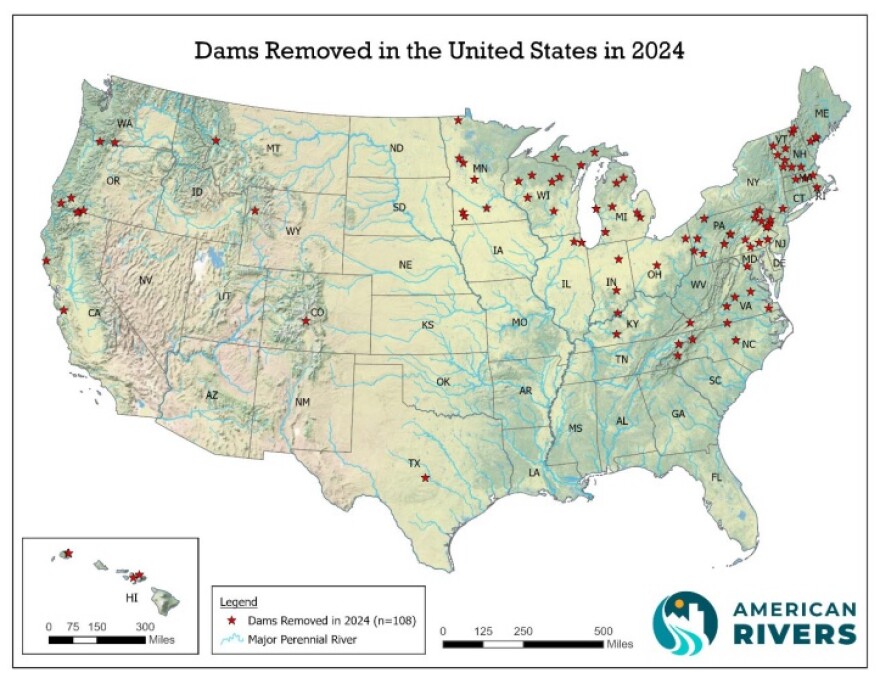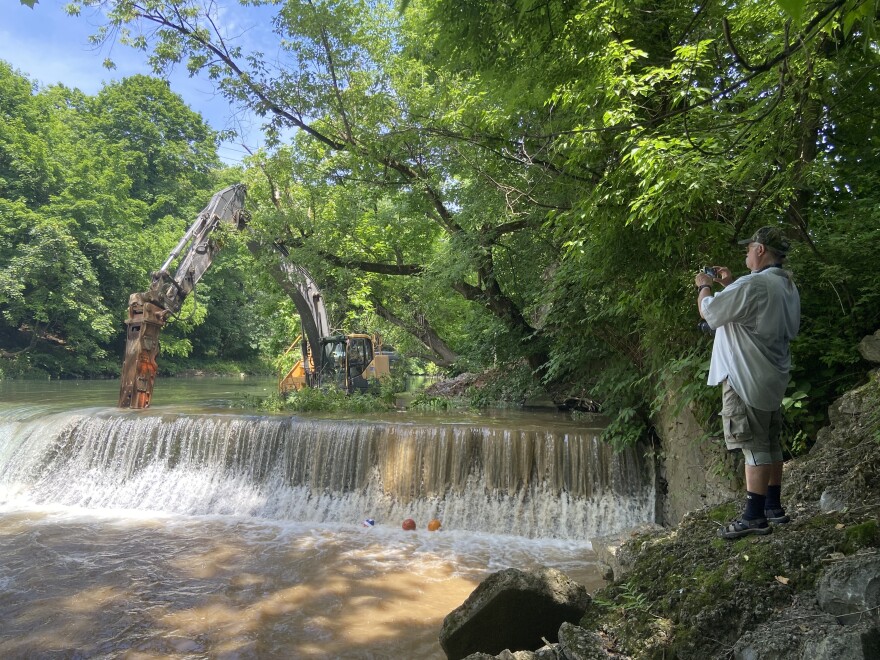BETHLEHEM, Pa. — When a dam is removed, there are immediate improvements, Kristie Fach said Tuesday.
“There's so many streams in Pennsylvania and so many dams that you don't even think about it during your commute," Fach, director of ecological restoration for Wildlands Conservancy, said.
"Everyone knows a dam in their neighborhood or in the community.
“One good thing about dam removal is that it can cover so many items — environmental benefits and recreation and liability — and that's immediately improved after you remove the dam. It’s an effective strategy.”
Last year was a big year for dam removals not only in the Lehigh Valley, but across Pennsylvania.
The commonwealth ranked first in the United States for the most outdated, unsafe and uneconomical dams removed in 2024, according to a recent report from American Rivers, a national nonprofit focused on clean water and river health.
“It is truly remarkable how fast a river recovers once it is returned to its free-flowing state."Serena McClain, senior director of American Rivers’ national dam removal program
Twenty-seven dams were removed last year from Pennsylvania waterways, including seven in Northampton County.
Removing dams restores the waterway’s natural flow, benefitting aquatic life and overall river health, experts said.
It also clears a liability that can put communities in harm’s way during catastrophic flooding and other extreme weather events.
“It is truly remarkable how fast a river recovers once it is returned to its free-flowing state," Serena McClain, senior director of American Rivers’ national dam removal program, said in a March 4 news release.
"In some instances, it only takes a few moments for fish to return upstream. Not only is dam removal good for river health, but it is also just a smart investment.
“Removing outdated and unsafe dams eliminates liability for municipalities and private landowners, improves public safety for local communities and overall river restoration lifts up local economies.”

Bushkill Creek
Dam removal projects have been ongoing in the Valley for several years, including on the Bushkill Creek.
Bushkill Creek begins at the foot of Blue Mountain in Bushkill Township and flows for about 22 miles south to its confluence with the Delaware River.
It’s designated as a high-quality cold-water fishery, and its watershed encompasses 80 square miles.
The large-scale creek rehabilitation project, underway since 2021, included the removal of five dams, the last of which was razed over the summer.
“It's only a matter of time that a lot of these dams will be breached."Kristie Fach, director of ecological restoration for Wildlands Conservancy
The dams, once used for water-powered mills, had fallen into disuse and disrepair.
“The mill, oftentimes, will no longer be there, but yet, the dam is there, and it's causing a lot of problems to the stream,” Fach said.
“And then, in addition to all of the ecological damage, there are certainly safety concerns, and a dam is not going to be there forever with the storms that we've been getting an increased flow.
“It's only a matter of time that a lot of these dams will be breached. We're trying to do this in a way that's environmentally impactful, addressing a safety concern and also doing it in a way that's very well planned.”
With the structures still in place, it created a bathtub-like effect, leaving pooling water to go stagnant, building up sediment and blocking aquatic life from moving.
“The benefits of removing the dam, you're providing more flood capacity, like more flood storage,” Fach said. “So as we get more storm events or heavier storm events, we're creating more area for flooding.
“When you have a dam, everything is fully saturated — you're actually creating more erosion and more problems.”
With the dams removed, there are benefits to fish and eels, as well as hitchhiking mussels. For the first time in a century, they’re able to make their way from the Atlantic Ocean to the Delaware River and finally up the Bushkill.
In October, Wildlands and Lafayette College officials held a celebration, marking the completion of the restoration with a wildflower-planting.
Monocacy Creek
In addition to the fifth dam removed from the Bushkill, six structures last year were removed from the Monocacy Creek.
Monocacy Creek, which flows into the Lehigh River near downtown Bethlehem, passes through Bushkill, Moore, East Allen, Upper Nazareth, Lower Nazareth and Hanover townships.

Like the Bushkill, it's designated as a high-quality cold water and migratory fishery.
The project included restoring the half-mile section of the Monocacy that runs through the Archibald Johnston Conservation Area in Bethlehem Township.
The clean-up and restoration work included removing bridges that have fallen into the stream, small dams that were diverting water flow and also a spring that had been impounded and was creating stagnant conditions.
‘Momentum is growing’
In addition to the dams removed last year in the Valley, Wildlands officials in August also worked on the removal of a dam on the Dilldown Creek in Tunkhannock Township, Monroe County.
Moving forward, Wildlands has plans to remove a series of five dams on Silk Mill Run, a tributary of the Lehigh River in Jim Thorpe, Carbon County, Fach said.
There also are plans to remove one more dam on the Bushkill that’s privately owned in Easton.
However, some of the funding for those projects comes from the National Fish and Wildlife Foundation — federal funding that has been or frozen by President Donald Trump.
“With the federal funding freeze, we're still in limbo,” Fach said. “We have grant funding, but everything is on pause until we know what's going on with the funding.
"So hopefully those removals will happen next year.”
While Pennsylvania took first in the country for most dams removed last year, 26 other states removed at least one dam.
"If we didn't have the funding, or if we didn't have the state assisting in the permitting process and working together, we certainly wouldn't be able to accomplish as much as we have."Kristie Fach, director of ecological restoration for Wildlands Conservancy
Michigan saw 10 removals, and Minnesota and Virginia had seven each.
“We've been the leader for many years, and it's great that there's other states that are now,” Fach said. “The momentum is growing for stream restoration and dam removal.”
Fach attributed the commonwealth’s many removals to the partnerships forged in the process.
“The reason that we're able to remove so many is that we have so many partners working together on it,” Fach said.
“If we didn't have the funding, or if we didn't have the state assisting in the permitting process and working together, we certainly wouldn't be able to accomplish as much as we have.
“And then also having landowners that are more aware of the benefits, because we wouldn't be able to do a dam removal without their approval. That's a huge part of it.
“So the more awareness that's out there, and everyone working together — that's where the momentum keeps growing."


